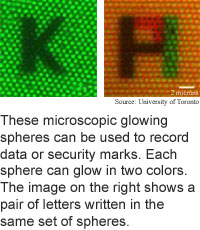
Nanoparticle dyes boost storage
By
Eric Smalley,
Technology Research NewsShrinking the size of fluorescent dye particles is one way to cram more information into optical data storage devices, but dye particles can be made only so small.
Researchers from the University of Toronto have found a way to put layers of different dyes into a single particle, making it possible to record several bits of data on the same spot. The technique could increase data storage capacities several-fold, and improve anticounterfeiting measures.
The researchers' method involves a thin film of particles that can be applied to a surface. Data is recorded on the film by shining lasers tuned to specific wavelengths, or colors, at particular particles to activate the fluorescent dyes they contain. The activated dyes glow when exposed to lower-intensity light tuned to a second wavelength. Different dyes are activated and read by different wavelengths of light.
The microscopic dye particles could be used to print large amounts of information onto surfaces of documents, photographs and packaging, said Eugenia Kumacheva, an associate professor of chemistry at the University of Toronto. Detailed codes, patterns or images can be used as unique, difficult-to-duplicate, identifiers. And dyes that can be read only under ultraviolet or infrared light can be used to make the recordings invisible.
The particles can also be used to cram a large amount of information onto optical data storage media, according to Kumacheva. "These materials are equally important for high-density optical data storage and encryption of different patterns for personal identification for security purposes," she said.
The key to cramming more information in the same space is making the particles in layers, with each layer containing a different dye. The researchers made particles containing two and three dyes. Each dye is mixed with a different type of polymer. Two-dye particles contain a 700-nanometer diameter core and a 150-nanometer thick shell. Three-dye particles require an additional 50-nanometer-thick inner shell. A nanometer is one millionth of a millimeter. In comparison, a red blood cell is 5,000 nanometers in diameter.
Using two-dye particles, a given spot can hold two bits of data rather than one, and a three-dye particle film is capable of recording three bits per spot. "This approach leads [to] a much higher density in data storage [that] would be difficult to counterfeit," said Kumacheva.
The researchers' scheme avoids a problem common in similar work, said Kumacheva. Even with different light sensitivities, an unilluminated dye particle can gain energy from a nearby illuminated particle. "Other light-sensitive materials including dyes or pigments have [not] allowed multiple writing on the same spot without crosstalk between the patterns," she said.
Because the multi-dye core-shell nanoparticles are fluorescent at several specific wavelengths, they could also be used to make tunable lasers and other photonic devices, according to Kumacheva.
The researchers are working on optimizing the recording procedure and finding better combinations of dyes, said Kumacheva. The printing method could be used for practical applications in five years, she said.
Kumacheva's research colleagues were Hung H. Pham, Ilya Gourevich, Jung Kwon Oh and James E. N. Jonkman. The researchers presented the work at the Particles 2003 conference in Toronto in August. The research was funded by The Canada Research Chair Fund (NSERC Canada).
Timeline: 5 years
Funding: Government
TRN Categories: Nanotechnology; Cryptography and Security; Materials Science and Engineering; Data Storage Technology
Story Type: News
Related Elements: Technical paper, "A Multidye Nano Structured Material for Optical Data Storage and Security Data Encryption," presented at Particles 2003, Toronto, August 23-26, 2003
Advertisements:
January 14/21, 2004
Page One
Quantum dice debut
Pressure shapes plastic
Software repairs itself on the go
Nanoparticle dyes boost storage
Briefs:
Fiber optics goes nano
Melted fibers make nano channels
Wet biochip preserves proteins
Nanotubes grown on plastic
Hardy molecule makes memory
Atoms make quantum coprocessor

News:
Research News Roundup
Research Watch blog
Features:
View from the High Ground Q&A
How It Works
RSS Feeds:
News
Ad links:
Buy an ad link
| Advertisements:
|
 |
Ad links: Clear History
Buy an ad link
|
TRN
Newswire and Headline Feeds for Web sites
|
© Copyright Technology Research News, LLC 2000-2006. All rights reserved.